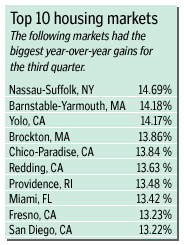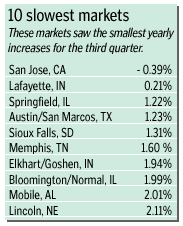New York (CNN/Money) -
The Chicago neighborhood of Rogers Park was for years overlooked by the real estate community.
Despite its rich architecture and ideal location -- it sits on Lake Michigan within short commuting distance of downtown -- high crime rates and too few grocery stores, restaurants and other services kept would-be homebuyers away until the late 1990's. But times have changed.
Now, many of Rogers Park's old architectural gems have been fixed up, new businesses are moving in and the city is spearheading a $60 million development at one of the neighborhood's "el" train stops. Real estate prices, not surprisingly, are climbing fast. According to real estate agent Jim McFarlane, they've gone up 18 percent in the past year.

"We are literally a block from the lake," said Dina Frieri, who bought a two-bedroom condominium in one the neighborhood's renovated vintage buildings in December. The 36-year-old Saks Fifth Avenue manager paid roughly half the price of a similar apartment in her old neighborhood. "We think within five years we're going to double our investment."
Such scenarios are playing out in cities, both large and small, across the country as older neighborhoods that were once abandoned for suburbia are being rediscovered and revitalized.
In Harlem, prices have doubled over the past three years, according to Klara Madlin, a real estate agent there. In Seattle's southeastern neighborhood, Columbia City, prices have followed a similar trend. "I paid $99,000 for a craftsman style bungalow in 1994 and sold it for $230,000 two years ago," said Darryl Smith, a Seattle real estate agent.
Young urbanites aren't the only ones driving the trend.

"A lot of empty nesters are moving into downtown Denver because they can walk around and go to shops or restaurants," said Bill Bronchick, an author and attorney who specializes in real estate investing. "Downtown Denver used to have rows and rows of boarded up houses selling for $10,000, but now those houses are selling for $150,000 on the low end, and lofts are going for $1 million."
Adds Robert Irwin, author of "How to Find Hidden Real Estate Bargains:" "Even in small cities people have incentive to move back to old neighborhoods because they are often cheaper, they are closer to everything, and in many cases the architecture is better."
Be early, but not first
Buying property in what you hope is an up-and-coming neighborhood is one way to stretch your housing dollars and potentially score on your investment. But if you want to be successful, you need to get in at the right time, know the neighborhood inside and out, and plan to stick around for a while. As with any investment, it's all about balancing your tolerance for risk with profit potential.
You stand to make the most money, of course, by getting into a neighborhood early, but there's always the risk that others won't follow, that property values won't rise and that you'll get mugged or burglarized in the meantime.
"I always look to see if other properties have turned around, because if you're the first in you may really get hammered," said Irwin. He and other experts say it's important to see that fellow homebuyers, the city and business owners are making long-term commitments to the neighborhood.
Still, if you're after a potential diamond in the rough, don't wait too long. "Usually, if you read about it in the local paper as the next 'hot' neighborhood, the best deals are already gone," said Bronchick, adding that Starbucks coffee shops are a telltale sign that a neighborhood has turned.
Don't be afraid to get your hands dirty
According to Dale Mattison, a real estate broker in Chevy Chase, Md., another important factor to consider is architecture. "The first neighborhoods to turn around are those where the housing stock is interesting," he said, adding that Victorians, Federal style and other kinds of prewar building are particularly desirable.
Just keep in mind that bringing such properties to their full potential is probably going to take some work, whether you do the fixing up yourself or hire someone to do it for you. It also can cost big bucks, depending on how dated and in need of repairs it is.
As an extra incentive, however, you may be able to get special deals on mortgages or even grants for remodeling in neighborhoods that have been targeted for urban renewal.
Test drive the 'hood
But before you invest time and money into rehabilitating a Victorian in tomorrow's hot zip code, be sure to do some due diligence on the neighborhood itself. Eat in local restaurants, go grocery shopping, run errands and even do a dry run of your daily commute.
That said, some of the most important information you'll need can't be obtained by wandering around.
"You need to go to city council and see if there are any new businesses on the way, get crime statistics from the police department and look into the school system," Irwin said, adding that schools are often the single biggest factor in price appreciation for a neighborhood. "In other words, find out what the future holds for this area."
Invest for the long haul
Keep in mind your investment is likely to do better if you're able to stay put well after you've made the buy. Fixing up a property with the sole intention of flipping it could backfire.
"A lot of people have gotten hurt in real estate because they're too short-sighted. They get in too late and want to sell right away," said Bronchick.
This risk is particularly magnified in marginal neighborhoods, because they are often the first to see a drop in demand when the economy goes south. "What happens in a recession is that people want to feel safe, they don't want to try anything new," said Robert Kucharski, a real estate agent in Dallas.
According to Kucharski, the real estate market in Dallas today reflects what he believes is the worst housing recession since the oil bust of the 1980s. As such, he's adjusted his expectations for property he owns on the outskirts of Kessler Park, a trendy Dallas neighborhood. "I fix up homes and hold onto them, but now I'm seeing that I may be holding on to these properties longer than I had originally planned."

|

